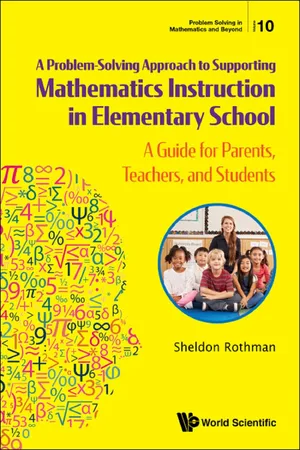![]()
Chapter 1
Introduction
William Paul Thurston
(1946–2012)1
A child prodigy, he was a recipient of the Fields Medal, the highest prize awarded in mathematics, and Professor of Mathematics at various universities. He also made significant contributions to mathematics education. In 2010, clothes designer Fujiwara and his associates designed and created a collection of women’s fashion based on Thurston’s geometric results.
MATHEMATICS is not about numbers, equations, computations, or algorithms, it is about UNDERSTANDING.
William Paul Thurston
Through problem solving, this book exposes the reader to a variety of topics taught in the elementary schools as well as additional related topics. A typical section will begin with a short introduction to the topic, followed by a problem and its solution. Various problem-solving techniques will be used in these solutions, and detours are often taken to point out and develop related mathematical concepts. Subsequent problems in each section will be of two types; one type can be considered practice. It does not introduce any new concepts and can be solved using the techniques of an earlier problem, whereas the second type extends the ideas of a previous problem and introduces new concepts. Some sections then include Additional Problems.
Since we learn much more by doing than we do by watching, the solutions to many of the problems appear at the end of the section. This is done with the hope that the reader will first attempt the problems on his/her own before turning to the solution.
A frequent misconception about mathematics is that it is a static subject, one where everything is known. Nothing could be further from the truth. Mathematics is an evolving discipline, just as it is for biology, physics, and all other academic subjects. Open questions will always exist in the mathematics realm. Some questions, like whether or not there are an infinite number of twin primes, can be understood by elementary school children, while others like the Riemann Hypothesis, a deep conjecture related to the distribution of prime numbers, requires an advanced mathematical background to even grasp its meaning.
What This Book Is NOT and What This Book IS?
This book is
• NOT a textbook;
• NOT just a list of clever problems.
This book IS
• a book that introduces concepts through problems first;
• a book for learning topics taught mostly in the elementary school;
• a book that approaches mathematics as a series of patterns, and values discovery of a general concept via the use of specific examples;
• a book that has both original and classic problems;
• a book that has problems for reinforcement;
• a book for the curious who want to more deeply understand the concepts taught in the elementary school;
• a book that takes the reader on a light-hearted journey that expresses problem-solving techniques;
• a book for elementary school students, higher level students who want to reinforce what they might have already learned, parents of elementary school children, elementary school teachers, and the set of mathematically curious individuals.
Some of the Problem-Solving Techniques Used
Look at smaller examples to determine a pattern;
Look at extreme cases;
Work backward;
Make connections to earlier work;
Produce counterexamples;
Use intuition and common sense;
Case-by-case analysis;
Brute force;
Intelligent guess and check;
Make an organized list.
How This Book Differs from Most Other Books
Concepts are introduced through problems first and then developed further as additional problems appear.
Main Goal of This Book
The goal of this book is not just to teach the reader topics taught in the elementary school but also to lead the reader on a path to becoming better at mathematics. Rarely do people enjoy activities they are not proficient at. As the reader unravels and begins to understand, the concepts presented here, he/she will enjoy uncovering the beautiful interconnections that make mathematics both useful and beautiful.
How We Plan to Accomplish This Goal
Many mathematics textbooks provide clear step-by-step procedures (algorithms) for solving problems while eschewing the discovery method. Others take the investigative approach and shy away from the algorithmic techniques and “drilling.” Here, we employ both styles, and this dual approach is reflected in the exercises. And of course, we will always stress the Why. Much of the “good stuff” will be transmitted through the exercises. To LEARN mathematics, you must DO mathematics. Watching is for moviegoers!
![]()
Chapter 2
Numeration Systems
Archimedes
(287-212 BCE)
Known as “The Sand Reckoner,” he is considered by many to be the greatest mathematician of all time. His work on finding volumes is similar to the methods used in modern calculus over 2000 years later. Archimedes discovered the principle of buoyancy while determining if a crown was made of solid gold, causing him to leap from his bath tub and run through the streets naked exclaiming, “Eureka!,” (I have found it!) Tragically, legend has it that while working on a geometric problem he had written out in the sand, Archimedes was killed by a Roman soldier when he refused the soldier’s command to be interrupted.
Mathematics reveals its secrets only to those who approach it with pure love, for its own beauty.
Archimedes
Since the time that the first mathematical writings appeared on bones and later cave walls, people have sought out ways to count and record numbers. Originally, people counted on their fingers and then by making tally marks, such as |||, one for each object, on wood, bone, and stone. These marks appeared in Africa as early as 40,000 years ago. This worked well for small numbers but not for larger ones. A numeration system is a method of representing numbers. Different numeration systems were developed by various civilizations to solve such difficulties as representing large numbers.
Egyptian System
The Egyptian System of Numeration, develop...


